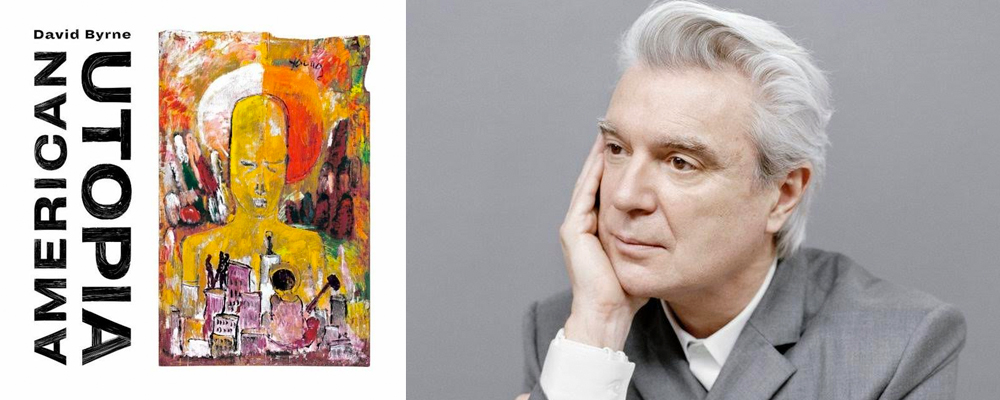David Byrne Invites You to an ‘American Utopia’
Adi Mehta
David Byrne wears big suits and has big ideas. Since his early days with the legendary Talking Heads, he has consistently stretched the limits of artistic expression. Now he has gone alternate reality on us, painting a picture of our world as it could be. Byrne has spoken before of how he doesn’t have “a nostalgic bone” in his body. True to his word, he expends no energy reminiscing the past. Neither does he waste a moment lamenting the present. Instead he imagines a fantastic future, and uplifts us by presenting the possibility of a paradise on his first solo album in 14 years, “American Utopia.”
The chorus of the opening track “I Dance Like This” is a plodding, mechanical stomp with discordant clangs and bursts of industrial noise, over which a robotic vocal asserts “We dance like this because it feels so damn good / If we could dance better, well, you know that we would.” The apparent sentiment is a longing for greater humanity — a relatable concern in today’s grim political and social climate. Leave it to Byrne to mount his bicycle and pedal away to the rescue. He takes on the job immediately, declaring on the very next song “Gasoline And Dirty Sheets,” “I will be a human being.”
It is a very peculiar thing to be a human being. Consider, for example, that a “cockroach might eat Mona Lisa,” or that “the pope don’t mean shit to a dog.” With these and other profound observations, Byrne draws attention to our unique circumstance, nature, and role in “Every Day Is a Miracle.” Upon the titular line, you can literally hear Byrne smiling — like the announcer of a voiceover in a commercial. Furthermore, his effervescent, exuberant positivity doesn’t seem to betray the slightest trace of irony. If such unbridled optimism seems a bit hard to take at face value amid today’s landscape, Byrne reassures us, “Hey! It’s not dark up here.” And if an “American Utopia” seems a far-fetched fantasy, he goes on to inform us, “Hey! It’s not very far.”
To back up these claims, Byrne has released his new record in conjunction with a multimedia presentation and lecture series titled “Reasons To Be Cheerful,” named after a 1979 song by Ian Dury and the Blockheads. In his lectures, Byrne relates how the creation of cultural institutions has transformed Brazilian favelas from crime-ridden no mans land into peaceful communities, and of how public transportation initiatives such as “City Bike” and exclusive bus lanes have remarkably relieved traffic congestion in cities throughout the world. He talks of politicians from humble beginnings who have managed to penetrate the system and change the conversation in spite of all odds against them, and of how music has the marvelous power to unite people of disparate backgrounds.
“You’ve got to sing for your supper,” Byrne demonstrates by example, “Love one another.” This is the stuff of temple beads, amulets, fluorescent vests, and unicorn horns — odd when you consider that Byrne is a punk icon, hailing from the ‘70s New York City scene that defined itself largely as a rebuttal to the hippies. But then, Talking Heads were always the upbeat bit of the bunch — in terms of both rhythmic conveyance and philosophical perspective. In fact, Byrne makes the case that the two come hand in hand. In “This Is That,” he declares, “When the melody ends and the rhythm begins, it knows where I’m at, and it know where I’ve been.”
Indeed, “American Utopia” is a predominantly rhythm-centered affair in the tradition of Byrne’s work with longtime collaborator Brian Eno. The album began as a set of instrumentals that Eno sent Byrne to develop into songs. Byrne, in turn, went way outfield, inviting a fleet of musicians from around the world to make generous contributions. Eventually, the songs took on such a character of their own that Eno found it fit to credit the work solely to Byrne. Musically, “American Utopia” is everything we’ve come to expect from Byrne. It’s a set of simple songs with eccentric sensibilities. There are moments when the percussive fervor relives the adventurous spirit of “Remain In Light”-era Talking Heads. The frequent inclusion of exotic instruments continues the fascination with world music that Byrne has demonstrated over the years in works such as “Rei Momo.” Certain songs recall Byrne’s collaborative projects of recent years. The sugary brass-led chorus of “Gasoline and Dirty Sheets,” recalls Byrne’s work with St. Vincent, while the chorus of “This Is That” appears to be lifted from “Fluorescent Half Dome” by former collaborators Dirty Projectors.
A clear album standout is the penultimate track, “Everybody’s Coming To My House,” an afrobeat riot of syncopated rhythms shuffling and ricocheting in tandem with pitch-shifting percussive leads to trance-like effect. The vibrant physicality of the music is worlds away from the stiff, monotonous drive of the album opener, over which the word came, “If we could dance better, well, you know that we would.” It’s as if Byrne means to tell us, ‘Here, now you can.’ Consider, in context, the outro of “This Is That,” in which he bleats, “This is when / This is now / This is that / This is how.” By imagining an “American Utopia,” Byrne has given us a glimpse of what could be, so that we might maybe go on to create it.
“American Utopia” is available March 9 on Apple Music.

